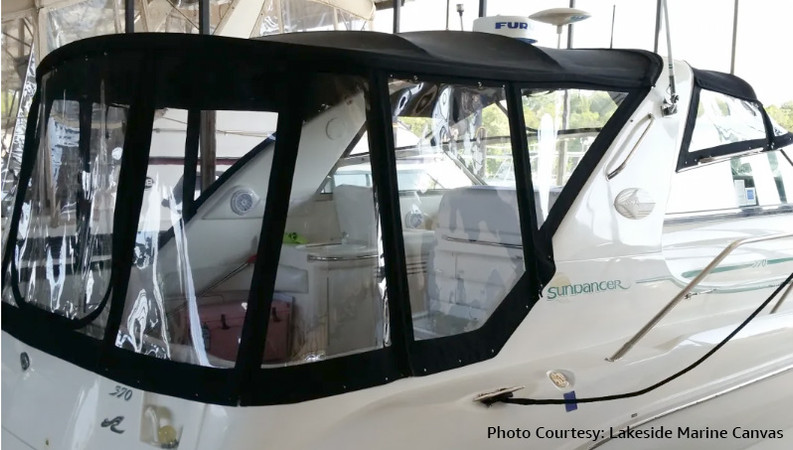How To Clean and Restore Eisenglass, Strataglass, Regalite and Other Vinyl and Plastic Windows
Posted by Flitz International on 25th Jul 2022
I’ve always loved convertibles. As long as the sun’s out and the top is down I’ll drive to nowhere in particular as long as there’s gas in the tank. I’m on my fifth convertible and only complaint I ever had was the awful vinyl rear window in the convertible top. If you’re a boat owner, you also know what I’m talking about. Older vinyl roll windows or Eisenglass was all there was years ago, and they all faded, cracked and yellowed in what seemed like no time at all. If you’re dealing with yellowed Eisenglass or its newer cousins; Strataglass, Regalite and others, grab a chair because there’s hope.
What is it?
Things bearing the name Eisenglass (and its spelling variations) have changed over the years. Originally a type of glass made with the mineral mica, today’s Eisenglass is just as accurately described as clear vinyl sheets. These clear vinyl sheets offer varying degrees of visibility. Their flexibility allows them to be fashioned into all shapes of windows and deck enclosures. Brand new, they’re very good. A couple years in the salt and sun and they become atrocious in short order. Brands like Strataglass and others offer longer lifespan and better visibility, but the price tag is commensurate. No matter which brand you have, you still have to clean them. And, after the elements take their toll, you’ll want to restore them.
Cleaning Do’s and Don’ts
Like a lot of folks, your first instinct when it comes to cleaning dirty vinyl boat windows is to grab for old faithful, a bottle of Windex. For goodness’ sake, don’t do it! You will do more damage with old blue than you can imagine. It’s not a vinyl cleaner. And for heaven’s sake, don’t use paper towels on your Eisenglass! A lot of folks don’t realize that paper towels are, in fact, abrasive. While not assigned a specific grit number like sandpaper, anyone who’s made the mistake of using a paper towel on vinyl or acrylic will tell you it that it’s a bad idea. To clean your vinyl or Eisenglass windows or enclosures your best friends are fresh water, a gentle soap and a good microfiber cloth or synthetic chamois.
Always thoroughly rinse your vinyl windows with water to remove any salt or other minerals, followed by a mild soap and dry with a soft cloth or microfiber. Beware of cleaners with silicone or harsh chemicals. Even something like Simple Green is a bad idea on vinyl. There are a host of ultra-gentle boat cleaners out there. You should seek them out and avoid cleaners from the grocery store like the plague.
Now What? More Warnings?
Once clean and dry, it’s time to polish that vinyl. This too comes with several warnings, so let’s begin. Never, never, never touch your vinyl windows with sunscreen on your hands. Just don’t do it. Ditto for bug spray. Don’t spray that stuff near your vinyl. Very bad. And lastly avoid, wax or “scratch removers”. This means don’t use Pledge either. Depending on the quality of your vinyl, Pledge and others like it may appear to work, but on more expensive brands like Strataglass you can do way more harm than good.
What Polish?
There are number of specific polishing products made just for the different brands of clear vinyl windows. Most are pretty good, and if you don’t mind paying through the nose for them, go right ahead. And while we always encourage folks to follow manufacturer’s recommendations, we on the other hand, like to take a thriftier approach. Why not use something you already have on the boat?
Surprise! That can of Flitz Polish that you used to return your boat’s brightwork to a mirror shine, will not only polish your newly cleaned vinyl windows and Eisenglass, it’ll even restore the foggy, yellowed panels that you were sure were goners! Seriously!
Easy Peezey
Here’s what you do:
- Remove the vinyl window panels and lay them flat on a soft towel or remnant piece of carpet.
- Apply an ultra-thin film of Flitz Polish to at most a two foot by tow foot area of the vinyl.
- Don’t let the polish dry. Rub the polish into the vinyl with a soft microfiber towel.
- Buff the area a separate, clean microfiber to bring out that shine!
- Move on to another area, and when done, flip the panel over and repeat on the other side.
It really is that easy! Now, if your vinyl is really fogged and/or yellowed, you may need a little help in the elbow-grease department. That’s where a corded or cordless drill and a Flitz Buff Ball come in. The extra pressure and speed of the Buff Ball will quickly chase away that oxidation and yellowing. Stubborn areas may need a second application of polish, but never use more than one thin layer at time. Any more than that and you’re wasting polish and making a mess. Plus, our Buff Ball’s design is self-cooling, so you never have to worry about the viny getting too hot and melting!
Flitz Polish will protect that vinyl for up to three months, even in salt water. If you’d like to extend the protection, you can apply our Flitz Ceramic Sealant after you polish to make your vinyl ultra-hydrophobic and protect it for six months or more! Either way, it’ll be clear seeing and clear sailing!
And that’s really all there is to it. Always check product and manufacturer’s recommendations before you begin just to be safe. Start on a small area until you get the hang of things to ensure the best experience. Also remember that we’re always here to help. If you’ve got questions, drop a note to info@flitz.com and we’ll be happy to assist!

